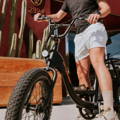Correct Tire Pressure for Fat Tire Electric Bikes
Written by: Rémy Rossi | August 24, 2025 | Time to read 3 min
Fat tire e-Bikes run low pressures anywhere from 5 to 30 PSI. Here’s how to zero in on the exact pressure that’s perfect for your next ride.

More about the Author: Remy Rossi
Rémy Rossi is a bike writer, mechanic, and educator who got his start in community-based bike shops and co-ops. With a decade in the industry, he still wrenches on bikes when he can and plays bike polo on a fixie.

Fat tires use significantly lower pressures

Why correct tire pressure is important
Recommended tire pressure for a fat bike tire

Frequently Asked Questions
How wide are fat tires?
How to choose a fat tire bike?
What PSI should I run on my fat bike in snow?
Key Takeaways
- Fat tire e-Bikes run much lower pressures (5–30 PSI) than standard bikes.
- Lower PSI improves grip and flotation on soft terrain like snow or sand.
- Higher PSI (20–30) is best for pavement and hard-packed trails to reduce rolling resistance.


